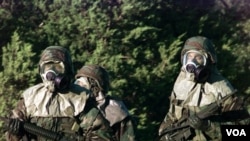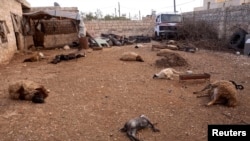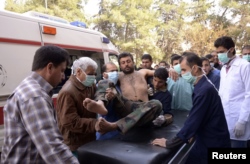On July 7, the U.S. announced that it had destroyed its last chemical weapons stockpile, closing a chapter of warfare dating back to World War I.
“For more than 30 years, the United States has worked tirelessly to eliminate our chemical weapons stockpile,” President Biden said in a July 7 statement, “Today, I am proud to announce that the United States has safely destroyed the final munition in that stockpile — bringing us one step closer to a world free from the horrors of chemical weapons.”
When asked if Beijing had any comments on this development, Chinese Foreign Ministry spokesperson Mao Ning responded:
“It was stipulated in the CWC (Chemical Weapons Convention) that States Parties shall complete the destruction not later than 10 years after the entry into force of the CWC in 1997. The US is the last state to complete the destruction of its declared chemical weapons stockpile, far behind the time limit set in the CWC.”
That is misleading.
The Chemical Weapons Convention (CWC) “prohibits the development, production, acquisition, stockpiling, retention, transfer or use of chemical weapons by States Parties.”
One hundred and thirty countries, including the United States, signed the Convention in 1997, vowing to destroy their chemical weapons stockpiles within 10 years.
If the CWC required member states to eliminate their stockpiles by 2007, why did it take the U.S. so long to eliminate its stockpiles?
First, these weapons were tricky to handle, as they contained deadly chemicals crammed into artillery shells, rockets or bombs. “They were built to be fired, not disassembled. The combination of explosives and poison makes them exceptionally dangerous to handle,” The New York Times reported.
Then, there was the disposal process. While incineration is the U.S. Defense Department’s preferred method, local American residents resisted, fearing dangerous pollution. A grassroots organization, the Chemical Weapons Working Group, was formed and began to advocate for technologies other than incineration.
As a result, entirely new techniques had to be developed, and the U.S. employed various chemical processes to destroy these dangerous agents. For example, mustard gas was broken down by bacteria, while sarin gas was chemically deactivated before it was destroyed. The need for alternative methods of disposal significantly extended the U.S. timeline to safely destroy these warfare agents.
Another factor, according to David Koplow, a law professor at Georgetown University in Washington, D.C., was that the program was poorly managed. "The leadership for the program changed repeatedly and it was just never taken as seriously as it should have been," he told National Public Radio.
When the U.S. was unable to meet the 2007 deadline, Washington sought extensions from the Organization for the Prohibition of Chemical Weapons (OPCW), the Chemical Weapons Convention implementing body, to extend the deadline to September 30, 2023.
The U.S. met its commitment on July 7, 2023, when it destroyed its last stockpile at the Blue Grass Army Depot in Kentucky, and the OPCW confirmed that the "last chemical munition of the US' declared chemical weapons stockpile" had been "irreversibly destroyed."
A chemical weapon is any toxic chemical that can cause death, injury or incapacitation, and is considered a weapon of mass destruction. During the last century, many countries condemned chemical weapons.
According to the Arms Control Association, a non-governmental organization based in Washington, D.C, historians estimate that some 90,000 soldiers were killed by chemical agents during World War I.
The Geneva Convention of 1925 banned the use of chemical weapons but failed to ban their development and production.
From the start of World War I until the end of the Cold War, the U.S. stockpiled a large quantity of chemical weapons as a deterrent against other countries using similar weapons.
At one point, the United States had nine top-secret chemical weapons stockpiles spread from Maryland to Oregon, holding 28,600 metric tons of chemical agents.
According to the Centers for Disease Control and Prevention, the U.S. national public health agency, the U.S. primarily stockpiled six kinds of chemical warfare agents, principally mustard agents and nerve agents.
While all of the world’s declared chemical weapons have now been eliminated, the OPCW warns that some countries or groups still possess such lethal weapons.
North Korea, which has not signed the CWC, is widely reported to possess a large arsenal of chemical weapons, likely more than 5,000 metric tons.
Syria, which signed the CWC, admitted in 2012 that it had chemical weapons. However, it has been unwilling to disclose the size of its stockpile.
The OPCW registered 142 incidents of alleged chemical weapons use in Syria between 2015 and 2019. It mandated its investigation and Identification team to verify these incidents, and to name the perpetrators and victims.
The OPCW’s investigation and Identification team was able to complete its investigations of five incidents, and it identified Syrian government forces as the perpetrator of chemical attacks that affected (killed or injured) at least 161 victims. Other alleged incidents are still under investigation.







